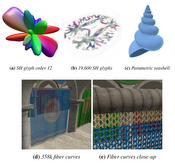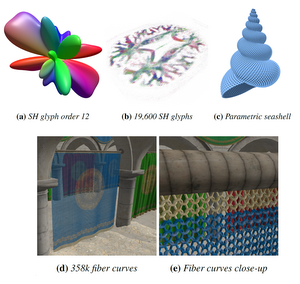Information
- Publication Type: Conference Paper
- Workgroup(s)/Project(s):
- Date: May 2024
- ISBN: 978-3-03868-243-1
- Publisher: The Eurographics Association
- Open Access: yes
- Location: Odense
- Lecturer: Johannes Unterguggenberger

- Event: Eurographics Symposium on Parallel Graphics and Visualization (2024)
- DOI: 10.2312/pgv.20241129
- Booktitle: EGPGV24: Eurographics Symposium on Parallel Graphics and Visualization
- Pages: 12
- Conference date: 27. May 2024
- Keywords: Tessellation Shaders, Point-Based Rendering, Parametric Objects, Fast Rendering, Modern GPUs
Abstract
Parametric functions are an extremely efficient representation for 3D geometry, capable of compactly modelling highly complex objects. Once specified, parametric 3D objects allow for visualization at arbitrary levels of detail, at no additional memory cost, limited only by the amount of evaluated samples. However, mapping the sample evaluation to the hardware rendering pipelines of modern graphics processing units (GPUs) is not trivial. This has given rise to several specialized solutions, each targeting interactive rendering of a constrained set of parametric functions. In this paper, we propose a general method for efficient rendering of parametrically defined 3D objects. Our solution is carefully designed around modern hardware architecture. Our method adaptively analyzes, allocates and evaluates parametric function samples to produce high-quality renderings. Geometric precision can be modulated from few pixels down to sub-pixel level, enabling real-time frame rates of several 100 frames per second (FPS) for various parametric functions. We propose a dedicated level-of-detail (LOD) stage, which outputs patches of similar geometric detail to a subsequent rendering stage that uses either a hardware tessellation-based approach or performs point-based softare rasterization. Our method requires neither preprocessing nor caching, and the proposed LOD mechanism is fast enough to run each frame. Hence, our approach also lends itself to animated parametric objects. We demonstrate the benefits of our method over a state-of-the-art spherical harmonics (SH) glyph rendering method, while showing its flexibility on a range of other demanding shapes.
Additional Files and Images
Additional images and videos
Additional files
Weblinks
BibTeX
@inproceedings{unterguggenberger-2024-fropo,
title = "Fast Rendering of Parametric Objects on Modern GPUs",
author = "Johannes Unterguggenberger and Lukas Lipp and Michael Wimmer
and Bernhard Kerbl and Markus Sch\"{u}tz",
year = "2024",
abstract = "Parametric functions are an extremely efficient
representation for 3D geometry, capable of compactly
modelling highly complex objects. Once specified, parametric
3D objects allow for visualization at arbitrary levels of
detail, at no additional memory cost, limited only by the
amount of evaluated samples. However, mapping the sample
evaluation to the hardware rendering pipelines of modern
graphics processing units (GPUs) is not trivial. This has
given rise to several specialized solutions, each targeting
interactive rendering of a constrained set of parametric
functions. In this paper, we propose a general method for
efficient rendering of parametrically defined 3D objects.
Our solution is carefully designed around modern hardware
architecture. Our method adaptively analyzes, allocates and
evaluates parametric function samples to produce
high-quality renderings. Geometric precision can be
modulated from few pixels down to sub-pixel level, enabling
real-time frame rates of several 100 frames per second (FPS)
for various parametric functions. We propose a dedicated
level-of-detail (LOD) stage, which outputs patches of
similar geometric detail to a subsequent rendering stage
that uses either a hardware tessellation-based approach or
performs point-based softare rasterization. Our method
requires neither preprocessing nor caching, and the proposed
LOD mechanism is fast enough to run each frame. Hence, our
approach also lends itself to animated parametric objects.
We demonstrate the benefits of our method over a
state-of-the-art spherical harmonics (SH) glyph rendering
method, while showing its flexibility on a range of other
demanding shapes.",
month = may,
isbn = "978-3-03868-243-1",
publisher = "The Eurographics Association",
location = "Odense",
event = "Eurographics Symposium on Parallel Graphics and
Visualization (2024)",
doi = "10.2312/pgv.20241129",
booktitle = "EGPGV24: Eurographics Symposium on Parallel Graphics and
Visualization",
pages = "12",
keywords = "Tessellation Shaders, Point-Based Rendering, Parametric
Objects, Fast Rendering, Modern GPUs",
URL = "https://www.cg.tuwien.ac.at/research/publications/2024/unterguggenberger-2024-fropo/",
}
 image:
Teaser image, different parametric objects
image:
Teaser image, different parametric objects
 paper:
Published Paper
paper:
Published Paper


 image
image paper
paper